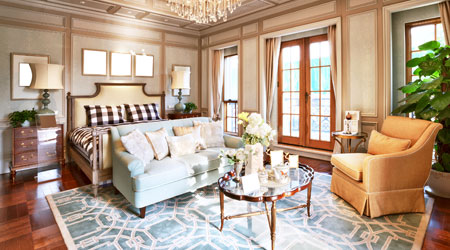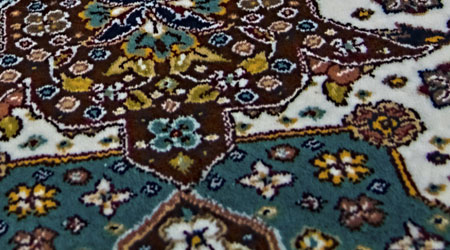The Story of Carpets: A Journey Through Time
Let's talk about carpets. They're one of humanity's oldest crafts, and they've been around for thousands of years. What started as simple floor coverings has grown into both an art form and a huge industry.
Ancient Origins and Discovery
When we dive into Ancient Origins and Discovery, we find that carpets are one of humanity's oldest crafts. They've been around for thousands of years. What started as simple floor coverings has grown into both an art form and a huge industry.
The oldest carpet we know about has quite a story. It was found in Siberia's Pazyryk Valley, and scientists date it back to the 4th century BC.They discovered it in 1949 in a nobleman's grave. What's really cool is that it was frozen in ice - that's why it's still in such great shape! This carpet, called the Pazyryk rug, shows amazing craftsmanship with 3600 knots per square decimeter. The design includes ribbons, deer, and warriors on horseback.
Early Nomadic Traditions
Looking at Early Nomadic Traditions, we see that carpet-making probably started with nomads in Central Asia. They needed something warm for those cold winters - something better than sheepskins, and something they could easily move from place to place. They used wool from their sheep and goats. Their looms were pretty simple, just two wooden pieces stuck in the ground. Modern nomads still use this type of loom today!
These early carpets weren't just functional - they told stories, too. In Islamic culture, those geometric patterns aren't just pretty designs. They represent faith and universal order, and many include sacred writing from the Quran.


Symbols and Meanings in Carpets
The symbols and meanings in carpets are fascinating. Central Asian carpets have their special symbols.
There's the "Tree of Life", showing the connection between heaven and earth. Then there's the "Evil Eye", design - people believed it kept bad luck away. Chinese carpets are different - they show dragons and phoenixes, which means wealth and power.
Colors matter, too.Red represents happiness in Chinese carpets, while blue stands for spiritual purity in Islamic ones. Each pattern and color has its special meaning.
If you have trouble cleaning your carpets, don't hesitate to contact Feet Up Carpet Cleaning of Laurel for professional assistance. Remember, carpets need to be cleaned regularly to maintain their appearance and longevity. Proper care helps preserve their beauty for years to come.
The Golden Age of Carpet Making
The Golden Age of Carpet Making came in the 1500s, especially in Persia and India. Royal families supported the best carpet makers, which led to some amazing pieces. The most famous? The Ardabil carpet. It's massive - about 17 by 38 feet! A team of five weavers took three years to make it. Today, you can see it in London's Victoria and Albert Museum.
Marco Polo helped spread the word about carpets when he saw them in Turkey around 1000 AD. Soon, Europeans went crazy for Oriental rugs. France bought so many that it hurt their economy! In 1608, King Henry IV had an idea - he started France's first carpet factory in the Louvre. Talk about fancy!

The American Carpet Revolution
The American carpet revolution tells its own exciting story. The U.S. carpet industry kicked off in 1791 when William Sprague started it all in Philadelphia. Here's something cool - Dalton, Georgia, is known as the "Carpet Capital of the World" and produces 70% of the world's carpet! The first wall-to-wall carpet installation in America was in 1791 in the Senate Chamber of Congress Hall in Philadelphia. The American carpet industry really took off after World War II, and by the 1960s, carpet sales hit $1 billion annually.
Industrial Innovation
Industrial innovation changed everything. A guy named Erastus Bigelow changed the game in 1839 when he invented a power loom just for carpets. Production doubled in one year! By 1850, it had tripled. Then came the really big change in the 1940s when Americans created "tufting". It's a totally different way to make carpets - no weaving needed! A tufting machine is superfast and can make 6 miles of carpet in just one day. When they added nylon and acrylic yarns to the mix, the carpet world changed forever.
Modern Technology and Innovation
Modern technology and innovation have made today's carpet industry more exciting than ever. Technology has opened up endless possibilities. Digital design tools let manufacturers create incredibly complex patterns and match any color you can imagine. Want to know something cool? Modern carpets can do some amazing things. Some carpets can actually clean the air in your home by trapping dust and allergens. Others are completely waterproof - spill your coffee? No problem! Some carpets even have built-in temperature control to help keep rooms warm in winter and cool in summer.
Environmental Revolution in Carpet Making
Green technology is changing everything about carpets. Let's break it down:
Water Conservation:
- New dyeing methods use 50% less water
- Some factories recycle 95% of their water
- Waterless printing technology is becoming popular
Energy Savings:
- Solar-powered carpet factories
- Heat recovery systems that save energy
- LED lighting in production facilities
Environmental Impact and Sustainability has become a major focus. The ecological side of carpet making is pretty impressive. New dyeing methods use 50% less water, and some factories recycle 95% of their water. Many companies now make carpets from recycled materials like old plastic bottles and fishing nets. Some carpets are even made from corn! When these carpets wear out, they can be recycled again - it's a complete circle. Installation has gotten pretty high-tech, too. Installers use laser measurements for perfect fits and have tools that can lay carpet without damaging walls or doorframes.
As carpets become more eco-friendly, professional carpet cleaning services can also help reduce environmental impact through sustainable cleaning practices.
Commercial Applications
Commercial applications have transformed dramatically. Office buildings have totally changed their carpet game. Remember those boring beige carpets? They're history! Now, we've got carpet tiles in every color and pattern. They're super practical, too - if someone spills coffee, you just replace one tile instead of redoing the whole floor. Hotels are getting creative with carpets, using them to guide people through buildings. The patterns can actually lead you to exits or elevators. Pretty clever, right? Some hotels even use glow-in-the-dark carpet fibers for emergency paths.
Health and Wellness Benefits
Many people are surprised by the health and Wellness Benefits of carpets. Did you know that carpets can actually help with indoor air quality? New carpets act like giant air filters, trapping dust and pollen. This helps people with allergies breathe easier. Schools love modern carpets, too, because studies show that carpet helps reduce noise in classrooms. This helps kids concentrate better and makes teachers' jobs easier. Plus, a soft carpet gives kids a comfy place to sit during story time.
The Future of Carpets
The future of carpets looks incredible. It's like something out of science fiction. Companies are developing self-cleaning carpets that break down stains using light, carpets that change color when you want them to, and smart carpets that can detect when someone falls and call for help. Some are even working on energy-generating carpets that make power from people walking on them! The carpet industry employs over 40,000 people in the U.S. alone - that's a lot of folks working to keep our feet comfortable.
Cultural Impact and Design Trends
Let's explore how carpets shape our culture today. Interior designers are doing amazing things with carpets. They're mixing traditional patterns with modern colors. Persian designs in neon colors? Yes, please! Abstract tribal patterns in pastel shades? It's happening!
Home design shows have changed how we think about carpets. Remember when wall-to-wall carpeting was out of style? Now it's back! But with a twist. People are layering area rugs over carpets. They're mixing textures and patterns. It's like art for your floor.
Social media has changed the carpet game, too. Instagram and Pinterest are full of carpet inspiration. Designers share their latest projects. DIY enthusiasts show off their room makeovers. Some carpet patterns have even gone viral! Who knew carpets could be social media stars?
The Modern Shopping Experience
The Modern shopping experience has completely transformed, too. Shopping for carpets has changed big time. Gone are the days when you had to visit multiple stores. Now, you can view carpets in virtual reality, order samples online, use apps to see carpets in your room, read thousands of customer reviews, and compare prices instantly. Taking care of carpets is easier than ever with stain-blocking treatments that really work, odor-fighting fibers, and quick-dry technology.
Continuing Legacy
Looking at this continuing legacy, we see how the carpet industry keeps growing and changing, connecting old traditions with new ideas. From ancient nomads to modern factories, carpets tell the story of human progress. They show how we can take something simple and make it amazing. As we look ahead, one thing's clear - carpets will keep surprising us. They'll get smarter, greener, and more beautiful. But they'll always do what they've done for thousands of years - make our spaces feel like home. Whether you're walking on an ancient Persian design or a modern smart carpet, you're part of a story that's been unfolding for centuries. And that story isn't ending anytime soon!